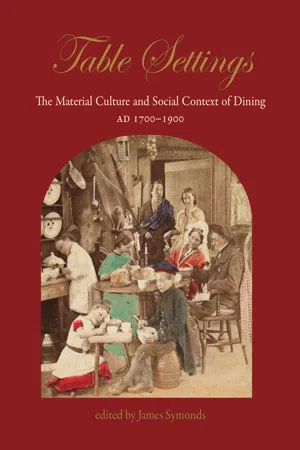Table Settings
About this book
Fernand Braudel famously observed that the 'mere smell of cooking can evoke a whole civilization'. The way that food is prepared, served, and eaten reveals a great deal about the structure and workings of any society. It is therefore not surprising that food, and the culturally specific etiquettes and equipment that surround the act of eating have been studied by scholars from a wide range of disciplines. The papers in this volume consider the changes that occurred in Old and New World dining and related culinary activities between the 17th century and the early 20th century. This period saw the widespread acceptance of the fork in dining and the adoption of routinized etiquettes to govern eating. In the 18th century the rise of individualism ushered in new forms of segmented dining based upon symmetrically arranged tables and individual place settings. Against this backdrop of manufactured uniformity, made possible by advances in industrial production, highly stylized dining rituals and haute cuisine, which had previously been the exclusive domain of European courtly elites, entered the homes and routines of the 'middling sort'. Henceforth, material expressions of status and social identity became commonplace at the table, and an integral part of dining in all but the humblest homes. The unique contribution of this volume lies in the way in which a distinguished group of international historical archaeologists have combined the richness of primary archaeological evidence with a wealth of documentary evidence to create insightful new material histories of dining. The new light which this throws upon manufacturing processes, feasting rituals, the rise of respectability, the inter-continental spread of the Victorian cult of domesticity, and foodways among peripheral agricultural communities will be of interest to scholars beyond archaeology, in the cognate fields of anthropology, social and economic history, cultural geography, and material culture studies.
Frequently asked questions
- Essential is ideal for learners and professionals who enjoy exploring a wide range of subjects. Access the Essential Library with 800,000+ trusted titles and best-sellers across business, personal growth, and the humanities. Includes unlimited reading time and Standard Read Aloud voice.
- Complete: Perfect for advanced learners and researchers needing full, unrestricted access. Unlock 1.4M+ books across hundreds of subjects, including academic and specialized titles. The Complete Plan also includes advanced features like Premium Read Aloud and Research Assistant.
Please note we cannot support devices running on iOS 13 and Android 7 or earlier. Learn more about using the app.
Information
Table of contents
- Cover
- Acknowledgements
- List of Contributors
- 1. Introduction (James Symonds)
- 2. Producing for the Table: A View from the Staffordshire Potteries (David Barker)
- 3. Trade Catalogues: Elaborations and Virtual Collections (Christine Ball)
- 4. Chocolatada! Sensing the Past: Recreating a 17th-Century Chocolate Recipe (Annie Gray)
- 5. Conspicuous Consumption: How to Organize a Feast (Joan Unwin)
- 6. Dining at Endcliffe Hall (Julie Banham)
- 7. Privy to the Feast: Eighty to Supper Tonight (Mary C. Beaudry)
- 8. Separating the Spheres in Early 19th-Century New York City: Redefi ning Gender amongthe Middle Class (Diana diZerega Wall)
- 9. Domesticity and the Dresser: An Archaeological Perspective from Rural 19th-CenturyPembrokeshire (Harold Mytum)
- 10. ‘We Lived Well at the Hagg’: Foodways and Social Belonging in Working-ClassRural Cheshire (Darren Griffi n and Eleanor Conlin Casella)
- 11. The Material Manifestations of 19th-Century Irish America (Stephen A. Brighton)
- 12 The Ceramic Revolution in Iceland (Gavin Lucas)
- 13. Gentility: A Historical Context for the Material Culture of the Table in the ‘Long 19th Century’,1780–1915 (Linda Young)
- 14. Feeding Workers: Food and Drink in Early Colonial Australia (Susan Lawrence)
- 15. A Not So Useless Beauty: Economy, Status, Function, and Meaning in the Interpretation ofTransfer-Printed Tablewares (Alasdair Brookes)
- 16. Postcard from Te Awamutu: Eating and Drinking with the Troops in the New Zealand War Front(Alexy Simmons)
